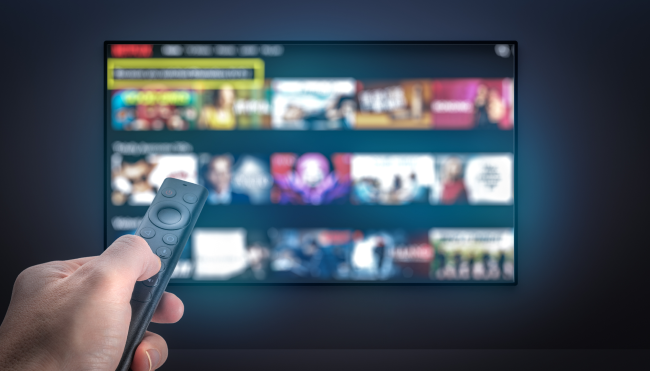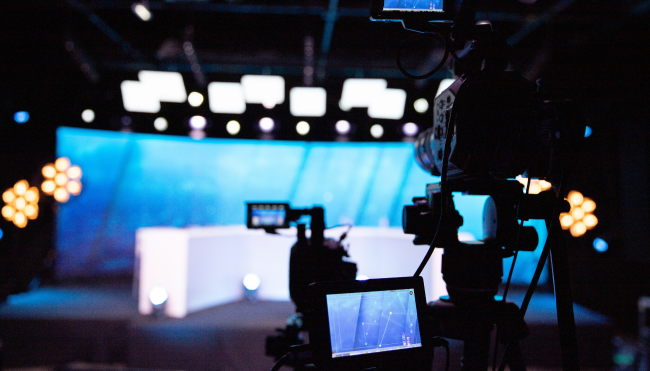- Why Amagi
-
Solutions
Contact UsBusinessWho We Serve
- Offerings
- AI
-
Resources
Contact UsINDUSTRY REPORTSAmagi FAST Report #15: The Power of Live Programming: A Catalyst for Streaming SuccessAugust 21, 2025Read More
-
Company
Contact UsNewsroomAmagi launches AI-powered Smart Scheduler to improve content programmingApril 3, 2025Read More
Blog
How to live stream sporting events with Amagi
By Kushagra Pandey - May 30, 2022
Live streaming sports via the cloud, while more economical than traditional live broadcasting, introduces unique challenges to sports broadcasting operations. Many broadcasters have complex needs (such as delivering streams to multiple platforms in different formats) that need to be addressed.
Rather than being a guide for beginners (people who need instruction on how to get enough internet bandwidth on the field, figure out camera angles, and start recording), this post is a resource for sports broadcasters with some existing production experience on how to live stream sporting events to as many platforms as they want.
The tools you use will have a major impact on the quality and profitability of your broadcast. If you want to deliver a financially efficient broadcast that your fanbase will enjoy, then you'll need a superior playout tool like Amagi, along with a few other key tools.
To that end, we explain:
- Three key tools you'll need to live stream your sporting events (and what features to look for in them).
- How to monetize live stream sporting events with dynamically inserted ads.
We also explain how you can use Amagi LIVE and Amagi THUNDERSTORM to deliver a high-quality live stream broadcast, minimize costs, and maximize ad revenue. To learn more about using Amagi for your sports streaming operation, contact our team.
How to live stream your sporting events

We'll start by assuming you already have a basic sports recording operation in place, including:
- A strong, stable internet connection.
- Audio and camera feeds that are being fed into a video mixer.
- A team to manage audio, video, and graphics.
- A director who's instructing the team on which audio/video feeds to switch to and which graphics to display.
At this point, you'll need three tools to perform your live stream: a video compression tool (encoder), a live stream orchestration tool, and a cloud-hosting vendor.
Stream encoder
The video file size from your MCR will be too big to stream over the internet. It needs to be compressed before you can go live.
Encoders use video transport protocols, such as SRT (secure reliable transport), to optimize video streaming performance by:
- Compressing the stream down to an appropriate size for transmission while maintaining the quality of the stream — for example, from 1Gbps down to 25 Mbps.
- Providing error correction — for example, if part of your stream gets dropped before it reaches its destination, the protocol will send it again.
The encoder(s) you use must use a streaming protocol that's supported by both the live stream orchestration tool you use and the platforms/channels to which you deliver your live stream.
You can use our live stream orchestration tool, Amagi LIVE, to compress your stream and deliver it to its destination. Amagi LIVE can act as both your MCR system and your encoder. You can either use it in addition to another encoder, to further ensure the highest quality broadcast, or you can use it instead of another encoder to save costs and simplify your live stream operation.
Cloud hosting vendor
Before you can deliver your live stream to the channels and streaming platforms it needs to reach, you must arrange for sufficient cloud infrastructure.
Cloud-hosting vendors such as Amazon Web Services (AWS) and Google Cloud Platform (GCP) offer a content delivery network (CDN) of servers placed all around the world so your live video can be delivered to viewers as quickly as possible.
If you live stream sports 24/7 (like ESPN, NESN, etc.), you will need permanent cloud hosting with your cloud hosting vendor. But if you only live stream occasionally, you can arrange temporary cloud hosting. That means you don't have to pay for hosting that you're not using actively.
With Amagi, you can purchase dynamic cloud hosting so that you only pay for what you use. Want to broadcast the Thursday night basketball games for a season and nothing else? That’s fine. With dynamic cloud hosting for your sports stream, you’ll only pay for the hours you stream games on Thursday night. Want to spin up a special channel for Olympics coverage and tear it down when you’re done? No problem. (And in case you’re curious about the quality of our service, we handled live playout for NBC’s Tokyo Olympics coverage).
Live stream orchestration tool

Live stream orchestration tools are responsible for delivering your live stream to the cloud-hosted servers and the end-user platforms your broadcast will play on at the scheduled time.
Not all live orchestration tools are built the same, and there are a few key criteria to consider when evaluating vendors:
- Which platforms it can deliver to
- What stream quality it can provide
- How much latency there is (the lag between what happens and when live stream viewers see the action)
- Whether it can handle captions and subtitles
- Whether it can record the stream for video on demand (VOD)
- What its graphics capabilities are
- What it can do to ensure uptime
- Whether you want to engage managed services or run everything yourself
1) Platform delivery
First, you need to ensure that your live streaming tool can deliver to the platforms (e.g Facebook Live, YouTube TV, Roku, etc.) you want to deliver to. Different platforms have different technical specifications dictating how live content must be delivered to them, and not all tools support those tech specs.
You can use Amagi LIVE to deliver your live stream to multiple FAST platforms, TV channels, your website, and your app. Amagi LIVE also supports dynamic platform delivery, so you can deliver certain parts of your sports broadcasts to some platforms but not others.
For example, imagine a broadcaster that's streaming a tennis tournament. They have the rights to stream the lower-tier matches on all their partner platforms, but can only stream the higher-tier matches (i.e. quarter-finals, semi-finals, finals) on select premium platforms. Normally, they'd need a large team of people to manage this process. But Amagi LIVE can handle such dynamic delivery requirements as needed, saving you significant management costs and reducing the complexity of your operation.
2) Stream quality
Most live sports broadcasts are being delivered at high quality nowadays (HD, 4K, etc.), and you must ensure your live streaming tool supports your desired stream quality.
Amagi LIVE can deliver high-quality streams in SD, HD, and 4K. Amagi LIVE can also handle dynamic stream-quality needs as well. Using the tennis streaming example from earlier, you could choose to stream lower-tier matches in HD but have higher-tier matches in 4K.
Or, if you're delivering to multiple streaming services with different stream-quality requirements (i.e. one needs HD and the other needs 4K), you tailor the stream quality to each platform's specifications.
Learn why university-owned Pac-12 Networks, streams 850+ live events per year, chose Amagi to handle live playout, program scheduling, and ad insertion.
3) Latency

Latency is the delay between when your sporting event is captured by cameras and when viewers see it on their screen. Most live streams have a latency of 30-120 seconds, which comes from a combination of:
- The time it takes for the broadcast team to process the video (from camera to MCR system).
- The time it takes for the live streaming tool to encode (i.e. compress into a streaming protocol) and send the stream out to the CDNs.
- The time it takes for the CDNs to receive the stream and send it to viewers.
But viewers watching live sports want to know what happens as soon as it occurs. They don't want to be the last to know or to have events spoiled by social media before they receive the stream on their screen. Imagine a scenario where someone is watching a boxing match on their mobile device and a tweet notification reveals the winner of the match before they see the actual finish.
Look for a live streaming tool that offers lower latency so you can minimize the time between when your MCR system sends the stream to the live stream tool and when CDNs receive it.
Amagi LIVE offers low-latency streaming, with an average latency of just 3-4 seconds from MCR system to CDN.
4) Captioning & subtitles
Adding captions and subtitles to your live streams is important for:
- Accessibility: Enabling people who speak different languages and/or have hearing or visual disabilities to enjoy your content.
- Clarity: Enabling all viewers to understand what's happening at all times (especially if they're watching at a bar or some other noisy area where they can't hear the play-by-play announcements).
- Regulatory Compliance: Depending on where you deliver your live broadcast, you may have to meet regional requirements regarding subtitles and closed captions (and the languages they need to be in).
But live sports streaming means you need to generate captions and subtitles in real-time. Many live streaming tools don't include any captioning and subtitle capabilities, requiring you to buy and manage a separate service for doing so.
But Amagi LIVE can insert captions and subtitles into your live stream in multiple formats (CEA-608, CEA-708, etc.) and in any language needed (depending upon where you deliver your broadcast to). We integrate with speech-to-text software (such as Lexi and Google) to create captions and subtitles for live events. We also offer human-generated captioning and subtitles (while staying within that 4-second latency window) if quality is your highest consideration.
5) VOD recording
Some viewers won't be able to watch your live broadcast when it airs. And some like to rewatch their favorite matches. That’s why many live sports broadcasters record their live streams for VOD delivery on their app, website, or other OTT platforms.
With Amagi LIVE, you can automatically record your live events and add them to your content library on any platform you deliver to, enabling you to monetize them again and again.
6) Graphics insertion

While the sports-related graphics (i.e. scoreboards, images of athletes, team stats, etc.) will be managed by the graphic mixers on your broadcasting team, you need a tool to insert promotional materials into your live stream.
Many live stream orchestration tools don't include native graphics capabilities. You'll have to buy a separate tool for inserting graphics, increasing the cost of your operation and adding another vendor you'll have to manage.
But Amagi LIVE has native graphics capabilities you can use to insert images and animations of…
- Channel logo and name (which may change depending on which platforms and regions your stream is delivered to)
- Promotional content (i.e. content that's coming "up next", future sporting events, etc.).
- Timers that countdown to the end of ad breaks
- Picture in picture (PIP) and L-band displays
With Amagi, you get access to rich dynamic graphics with real-time updates from an internet source and evergrowing designs from graphics creators. And since our proprietary software enables us to deliver top-quality graphics rendering using CPUs instead of pricier GPUs, our users save even more.
7) Redundancy
Downtime — i.e., when either the network you're using for your input stream (the stream from your MCR system to your live stream tool) or for your output stream (the stream from your live stream tool to the cloud) goes down — is one of the biggest issues live sports steamers must contend with.
Not only does it harm the viewing experience and potentially drive viewers away, it can also harm your monetization potential. For example, if your stream goes down in the middle of an ad, you won't earn income on that ad (or any other ads that would play while your stream is down).
So, make sure your chosen live streaming tool takes steps to avoid or at least mitigate downtime.
Amagi LIVE, for example, uses redundancy to prevent downtime. With redundancy, two parallel input and output streams are sent on different networks. If one network goes down, Amagi LIVE can just use the stream on the other network.
Another way Amagi secures your stream and prevents downtime is through managed services…
8) Managed services
If you're inexperienced with live streaming, you'll benefit from the security and comfort of managed services.
We can manage and monitor your live broadcasts from our operation centers in Bangalore and London. Some of our services include…
- Creative services: We can create pop-up channels for you (by building and tearing down cloud-hosting instances as needed) and create promos, highlights, and full-screen animations that match your channels existing design style.
- Scheduling services: We can use our vast experience and audience-insight to help you create engaging channel experiences and content schedules your viewers will enjoy.
- Tx ad Rx monitoring: We use sophisticated machine-learning technology to monitor feeds exactly as they are received by viewers and eliminate manual errors in monitoring to ensure highest SLA.
- Regional sub-feeds: We can localize your channels for every geography with opt-outs and time-shifting so your entire audience has an optimal viewing-experience.
Want to play out your sports broadcast with top-notch video and graphics quality while saving on costs? Contact our team to get started with Amagi.
How to monetize live stream sporting events

Live sports events present unique monetization challenges. Unlike other shows and prerecorded sports events, it’s more difficult to find appropriate opportunities for inserting commercial breaks that don't interrupt the viewing experience (like cutting to commercial just as a goal is about to be scored, for example).
To address the specific challenges of monetizing live sports, we recommend using a DAI (server-side dynamic ad insertion). Our DAI, Amagi THUNDERSTORM, has special capabilities that make it optimal for monetizing live sports events.
1) Flexible ad insertion
Amagi THUNDERSTORM is able to act on both fixed and flexible ad breaks. For example, using Amagi’s suite of tools, you can insert ad triggers into your stream at moments that you know will be opportune for commercial breaks, such as halftime. And you can insert flexible (manually-triggered) ad breaks when opportunities arise, such as during a time-out or when a player gets injured. This flexibility allows you to monetize content without interrupting the viewing experience.
Your production team on the ground can send flexible ad triggers in-the-moment, which eliminates the need for additional staff to manage ad breaks.
2) Nonlinear ads
Amagi THUNDERSTORM can insert nonlinear ads (for example, an L-band ad during gameplay) into your live streams, so you can monetize without cutting to a commercial break and interrupting the viewing experience.
You can insert split-screen ads, L-band images, quizzes, and more into your content, enabling you to boost monetization by inserting more ads into your content (and collecting more ad impressions) while viewers watch the action on-screen.
3) Dynamic ad delivery
One of the best features of our DAI is the ability to deliver targeted ads to viewers. With Amagi THUNDERSTORM, you can deliver:
- Contextually relevant ads: Ads that match the type of content (e.g. ads for lacrosse products during lacrosse games, NBA products during NBA games, etc.) viewers are watching.
- Localized ads: Ads that are region-specific (e.g. an ad for a local restaurant or real estate company).
- Product-specific ads: Ads that promote specific products to specific people (e.g. ads for clothing from the sports teams associated with your area — like Patriots and Celtics gear for viewers in Boston).
And with Amagi THUNDERSTORM's high-concurrency 'hyperscale' feature, you can send ads to tens of millions of simultaneous viewers on game day so you can monetize no matter how large your audience.
Learn More: Boost ad revenue with dynamic ad insertion for linear TV
4) Detailed ad analytics
Using Amagi THUNDERSTORM, you can view ad performance metrics in real time. Know your fill rate (and get ASRUN reports), plus gain insight into impressions, users, sessions, ad network performance, geolocation, and more.
You can then leverage this data to make informed decisions, demand a higher CPM from advertisers, and increase ad revenue over time.
Deliver better live broadcasts with Amagi

The tools you use to live stream sporting events will have a major impact on the quality and profitability of your broadcast. Amagi can help you deliver top-quality broadcasts, minimize costs, and maximize revenue by…
1) Reducing operational costs
With Amagi, you can handle stream encoding, stream delivery, caption and subtitle insertion, graphics insertion, and ad monetization all from one unified location — enabling you to reduce costs and minimize the number of staff and vendors you need to manage your broadcast.
2) Maximizing broadcast quality
With Amagi LIVE, you can deliver low-latency, high-quality streams to any platform your broadcast needs to reach. With built-in redundancy and our managed services add-on, you can minimize downtime to ensure your audience has an optimal viewing experience.
3) Handling dynamic requirement
Amagi LIVE can be used to handle many dynamic broadcasting requirements, including:
- Remote or on-site operation.
- Delivering one stream to multiple platforms in different stream qualities.
- Delivering different parts of a live stream to different platforms.
- Orchestrating multiple live-stream feeds with different ads and graphics playlists.
4) Providing superior monetization features
With Amagi THUNDERSTORM, you can monetize your live sports events with:
- Fixed and flexible ad breaks: Insert ad breaks without interrupting the action.
- Nonlinear ads: Insert ad overlays and animations while viewers watch the action on-screen so you don't need to cut away to commercials and can maximize monetization opportunities.
- Dynamic ad delivery: Deliver hyper-relevant ads that viewers are most likely to engage with, so you can charge advertisers more for impressions and maximize ad revenue.
If you want to supercharge your live sports broadcasts, contact our team.
Related Blogs
Get started
Increase revenue and reach with our Broadcast & Streaming solutions.
Cloud modernization. Streaming unification. Monetization. Marketplace.
 German
German French
French Spanish
Spanish Korean
Korean Japanese
Japanese Portuguese
Portuguese


